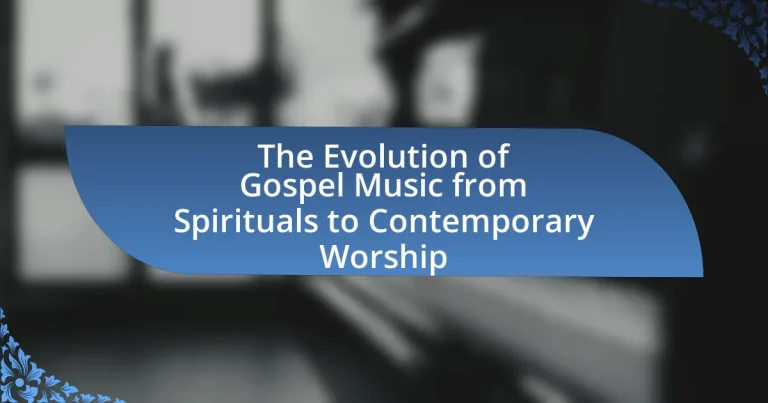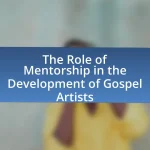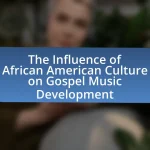The article examines the evolution of gospel music, tracing its roots from 19th-century African American spirituals to contemporary worship styles. It highlights the significant influence of spirituals on gospel music’s development, emphasizing themes of hope and resilience. Key figures such as Thomas A. Dorsey and Mahalia Jackson are discussed, along with the genre’s role in the Civil Rights Movement. The article also explores the transition to contemporary worship, characterized by modern musical styles and technology, and addresses future trends in gospel music, including the impact of social media and new artists on the genre’s direction.
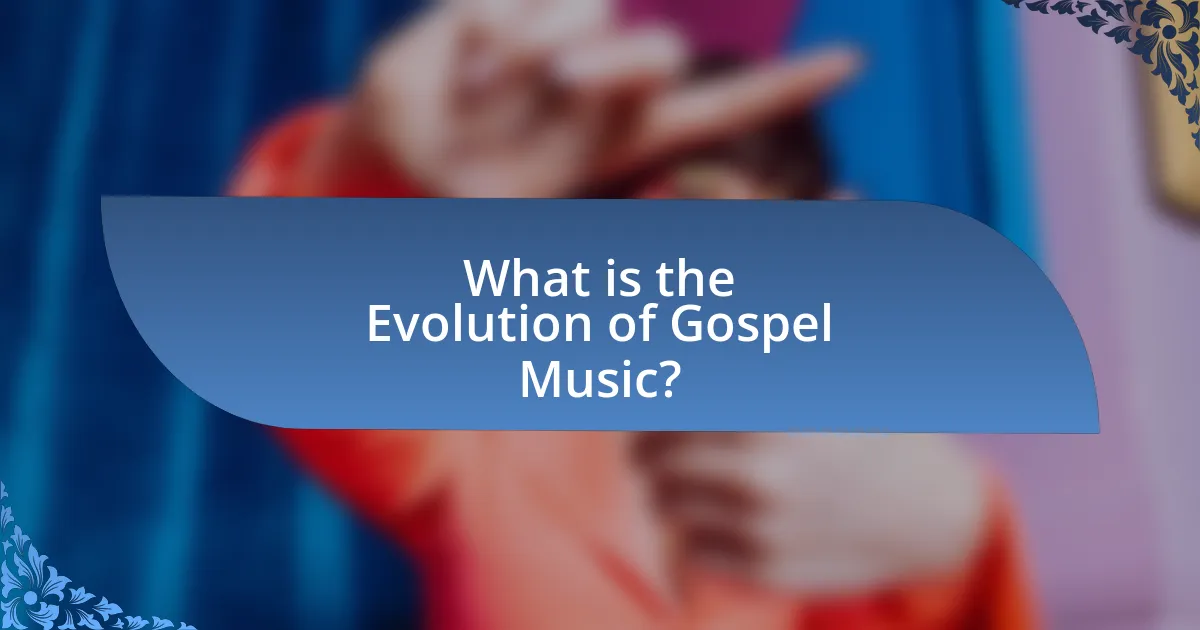
What is the Evolution of Gospel Music?
The evolution of gospel music encompasses its transformation from African American spirituals in the 19th century to contemporary worship styles today. Initially, spirituals emerged as expressions of faith and resistance among enslaved Africans in the United States, characterized by their emotive melodies and religious themes. In the early 20th century, gospel music began to incorporate elements of blues and jazz, leading to the rise of artists like Thomas A. Dorsey, who is often referred to as the “father of gospel music.” This period saw the establishment of gospel choirs and the popularization of gospel songs in churches.
By the mid-20th century, gospel music further evolved with the influence of rhythm and blues, leading to the emergence of artists such as Mahalia Jackson and Sam Cooke, who brought gospel to mainstream audiences. The late 20th century introduced contemporary gospel, which blended traditional gospel with modern musical styles, including hip-hop and pop, exemplified by artists like Kirk Franklin and Yolanda Adams. This evolution reflects broader cultural shifts and the ongoing adaptation of gospel music to resonate with new generations while maintaining its core spiritual message.
How did spirituals influence the development of gospel music?
Spirituals significantly influenced the development of gospel music by providing a foundational structure of emotional expression and communal participation. Spirituals, originating from African American religious traditions, emphasized themes of hope, suffering, and liberation, which became central to gospel music’s lyrical content. The call-and-response format prevalent in spirituals was adopted in gospel music, enhancing audience engagement and fostering a sense of community during worship. Additionally, the musical elements of spirituals, such as syncopation and improvisation, were integrated into gospel music, shaping its rhythmic and melodic characteristics. This evolution reflects the historical context of African American experiences, where spirituals served as both a form of resistance and a means of spiritual solace, directly informing the themes and styles of early gospel compositions.
What are the key characteristics of spirituals?
Spirituals are characterized by their deep emotional expression, religious themes, and use of call-and-response patterns. These songs often reflect the experiences of enslaved African Americans, conveying messages of hope, faith, and resilience in the face of adversity. The call-and-response format, where a leader sings a line and the group responds, fosters communal participation and reinforces the spiritual message. Additionally, spirituals frequently incorporate elements of African musical traditions, such as rhythmic complexity and improvisation, which enhance their emotional impact. Historical context shows that spirituals played a crucial role in the cultural identity and social cohesion of enslaved communities, serving both as a form of resistance and a means of spiritual solace.
How did the historical context shape spirituals?
The historical context significantly shaped spirituals by reflecting the experiences and struggles of enslaved African Americans in the United States. During the 18th and 19th centuries, spirituals emerged as a form of expression amidst the harsh realities of slavery, oppression, and the quest for freedom. Enslaved individuals used spirituals to convey their pain, hope, and resilience, often embedding messages of liberation and faith within the lyrics. For instance, songs like “Swing Low, Sweet Chariot” symbolized a longing for escape and divine intervention. This context of suffering and the desire for spiritual solace directly influenced the themes and emotional depth of spirituals, making them a powerful tool for both personal expression and communal solidarity among enslaved people.
What role did early gospel music play in African American culture?
Early gospel music served as a vital expression of African American identity and spirituality. It emerged from the spirituals sung by enslaved Africans, reflecting their struggles, hopes, and faith. This genre provided a means of communal worship and social cohesion, allowing African Americans to articulate their experiences and resilience in the face of oppression. Historical evidence shows that early gospel music was integral to the civil rights movement, with songs like “We Shall Overcome” uniting individuals in their fight for justice and equality. Thus, early gospel music not only shaped religious practices but also played a crucial role in the cultural and social dynamics of African American life.
How did gospel music serve as a form of expression during the Civil Rights Movement?
Gospel music served as a powerful form of expression during the Civil Rights Movement by conveying messages of hope, resilience, and social justice. This genre provided a soundtrack for the movement, with songs like “We Shall Overcome” and “This Little Light of Mine” becoming anthems that inspired activists and united communities. The emotional depth and spiritual roots of gospel music resonated with the struggles for equality, allowing individuals to articulate their pain and aspirations. Furthermore, gospel music was often performed at rallies and protests, reinforcing solidarity among participants and energizing the movement. The integration of traditional spirituals with contemporary themes highlighted the ongoing fight against oppression, making gospel music a vital tool for expression and mobilization during this pivotal era in American history.
What are the notable figures in early gospel music history?
Notable figures in early gospel music history include Thomas A. Dorsey, often referred to as the “father of gospel music,” who composed influential songs like “Take My Hand, Precious Lord.” Another significant figure is Mahalia Jackson, known for her powerful voice and ability to bring gospel music to a wider audience, particularly during the Civil Rights Movement. Additionally, Charles Albert Tindley, a Methodist minister, contributed to the genre with hymns that blended spirituals and gospel, such as “We’ll Understand It Better By and By.” These individuals played crucial roles in shaping the sound and direction of gospel music in its formative years.
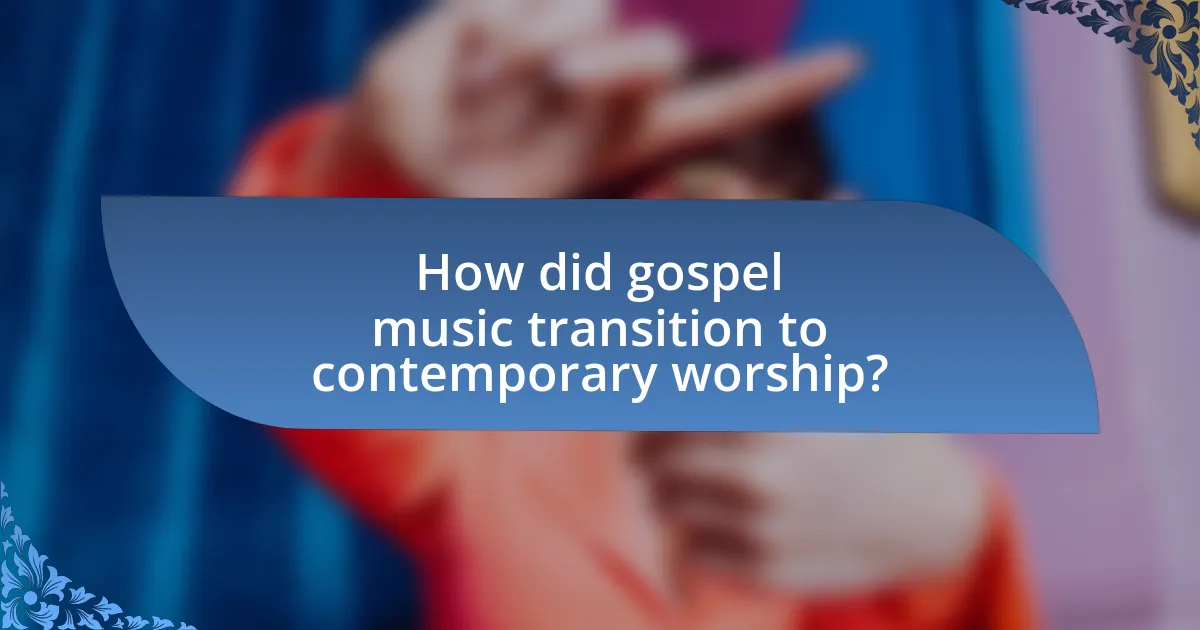
How did gospel music transition to contemporary worship?
Gospel music transitioned to contemporary worship through the incorporation of modern musical styles, instrumentation, and lyrical themes that resonate with contemporary congregations. This evolution began in the mid-20th century as gospel artists started blending traditional gospel elements with genres like rock, pop, and R&B, making the music more accessible and relatable to younger audiences. For instance, the rise of artists such as Andraé Crouch in the 1970s exemplified this shift, as he introduced contemporary arrangements and rhythms while maintaining the spiritual message of gospel music. This blending of styles not only revitalized the genre but also led to the development of contemporary worship music, which emphasizes personal and communal expressions of faith through diverse musical forms.
What are the defining features of contemporary worship music?
Contemporary worship music is characterized by its use of modern musical styles, accessible lyrics, and a focus on congregational participation. This genre often incorporates elements from pop, rock, and folk music, making it relatable to a wide audience. The lyrics typically emphasize personal and communal expressions of faith, often drawing from scripture and contemporary themes. Additionally, contemporary worship music frequently utilizes technology, such as digital sound systems and visual media, to enhance the worship experience. This evolution reflects a shift from traditional hymns to a more engaging and dynamic form of worship that resonates with today’s congregations.
How does contemporary worship differ from traditional gospel music?
Contemporary worship differs from traditional gospel music primarily in its musical style and cultural context. Contemporary worship often incorporates modern musical elements such as pop, rock, and electronic influences, while traditional gospel music is rooted in historical African American spirituals and hymns characterized by rich harmonies and call-and-response patterns. Additionally, contemporary worship typically emphasizes a more informal and participatory atmosphere, often utilizing multimedia and technology in worship settings, contrasting with the more structured and formal nature of traditional gospel performances. This evolution reflects broader changes in society and worship practices, as contemporary worship aims to engage a diverse audience in a relatable manner.
What instruments and styles are commonly used in contemporary worship?
Contemporary worship commonly utilizes instruments such as guitars, keyboards, drums, and bass. These instruments support various styles, including rock, pop, and folk, which are often characterized by a blend of traditional hymns and modern musical elements. The integration of these instruments and styles reflects a shift towards a more engaging and accessible worship experience, appealing to diverse congregations. This evolution is evident in the widespread use of contemporary worship music in churches, which has been documented in studies highlighting its impact on congregational participation and spiritual engagement.
Why has contemporary worship gained popularity in modern churches?
Contemporary worship has gained popularity in modern churches primarily due to its ability to engage congregants through relatable music and a more informal atmosphere. This style often incorporates modern musical elements, such as rock and pop influences, which resonate with younger audiences and create a sense of community. Research indicates that churches adopting contemporary worship styles have seen increased attendance and participation, as evidenced by a 2019 study from the Pew Research Center, which found that 47% of Americans who attend religious services prefer contemporary worship over traditional forms. This shift reflects a broader cultural trend towards personalization and relevance in spiritual experiences, making contemporary worship a compelling choice for many congregations.
What demographic shifts have influenced the rise of contemporary worship?
Demographic shifts such as urbanization, increased diversity, and generational changes have significantly influenced the rise of contemporary worship. Urbanization has led to a concentration of populations in cities, where contemporary worship styles often resonate more with younger, diverse congregations seeking relevance and connection. Increased diversity in congregations has prompted a blending of musical styles and cultural expressions, making contemporary worship more inclusive and appealing. Additionally, generational changes, particularly the preferences of Millennials and Generation Z, who favor authenticity and emotional engagement in worship, have driven churches to adopt contemporary worship practices that reflect these values. These shifts are supported by studies indicating that younger worshippers are more likely to attend services featuring contemporary music, thus shaping the overall landscape of worship in modern churches.
How do contemporary worship practices reflect current societal values?
Contemporary worship practices reflect current societal values by emphasizing inclusivity, community engagement, and emotional expression. These practices often incorporate diverse musical styles and cultural elements, mirroring the multicultural nature of modern society. For instance, many contemporary worship services utilize contemporary genres like pop, rock, and hip-hop, which resonate with younger generations and promote a sense of belonging. Additionally, the focus on personal testimonies and interactive worship experiences aligns with the societal value placed on authenticity and personal connection. Research indicates that congregations that adopt these practices often see increased participation and engagement, demonstrating a direct correlation between worship styles and the values of the community they serve.
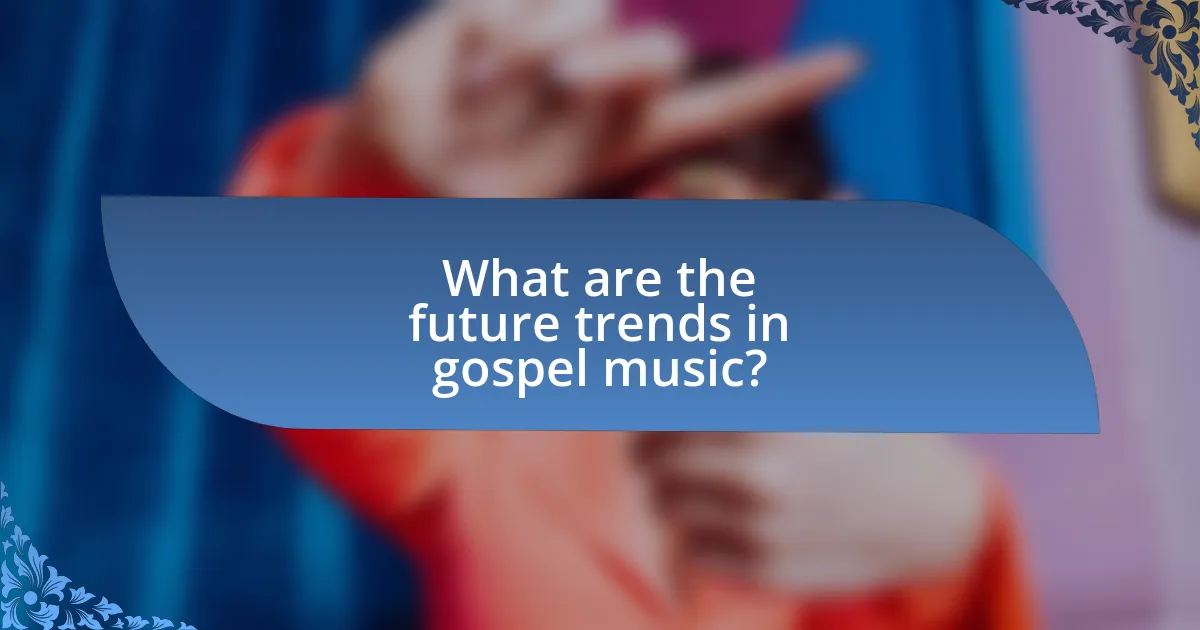
What are the future trends in gospel music?
Future trends in gospel music include increased integration of technology, diverse musical influences, and a focus on social justice themes. The rise of digital platforms allows artists to reach wider audiences and collaborate across genres, blending traditional gospel with hip-hop, R&B, and pop elements. Additionally, many gospel artists are addressing contemporary social issues, reflecting a shift towards music that not only uplifts spiritually but also engages with societal challenges. This evolution is supported by the growing popularity of gospel music in mainstream media, evidenced by the success of artists like Kirk Franklin and Tasha Cobbs Leonard, who have topped charts and received mainstream awards.
How is technology impacting the evolution of gospel music?
Technology is significantly impacting the evolution of gospel music by facilitating new methods of production, distribution, and engagement. Digital recording software allows artists to create high-quality music from home studios, leading to a broader range of sounds and styles within the genre. Streaming platforms like Spotify and Apple Music enable gospel artists to reach global audiences, increasing accessibility and diversity in the music. Additionally, social media platforms provide a space for artists to connect with fans, share their work, and promote events, which enhances community engagement and collaboration. The integration of technology in gospel music has led to innovative worship experiences, such as live-streamed services and virtual choirs, which became particularly prominent during the COVID-19 pandemic, demonstrating the adaptability of the genre in response to technological advancements.
What role do social media and streaming platforms play in gospel music today?
Social media and streaming platforms play a crucial role in the dissemination and popularity of gospel music today. These platforms enable artists to reach a global audience, allowing for the rapid sharing of new music and performances. For instance, platforms like Spotify and Apple Music provide gospel artists with the opportunity to distribute their music widely, while social media sites such as Instagram and Facebook facilitate direct engagement with fans, fostering community and support. According to a 2021 report by the Recording Industry Association of America, streaming accounted for 83% of total music industry revenue, highlighting the significance of these platforms in shaping the music landscape, including gospel.
How are new artists shaping the future of gospel music?
New artists are shaping the future of gospel music by incorporating diverse musical styles and modern themes that resonate with younger audiences. These artists often blend traditional gospel elements with genres such as hip-hop, R&B, and pop, creating a fresh sound that attracts a broader demographic. For example, artists like Travis Greene and Tasha Cobbs Leonard have successfully fused contemporary sounds with gospel messages, leading to increased streaming and chart success. This evolution reflects a shift in the gospel music landscape, where innovation and cultural relevance are becoming essential for reaching new listeners.
What can churches do to engage with the evolution of gospel music?
Churches can engage with the evolution of gospel music by incorporating diverse musical styles and contemporary artists into their worship services. This approach reflects the historical adaptability of gospel music, which has evolved from spirituals to include various genres such as hip-hop, R&B, and contemporary Christian music. By inviting local musicians and collaborating with contemporary gospel artists, churches can create a more inclusive worship experience that resonates with younger congregants. Research indicates that churches that embrace musical diversity often see increased attendance and engagement, as they cater to a broader audience and reflect the changing cultural landscape.
How can churches incorporate contemporary worship while honoring traditional roots?
Churches can incorporate contemporary worship while honoring traditional roots by blending modern musical styles with classic hymns and liturgical elements. This approach allows congregations to engage younger members through contemporary genres like pop and rock, while still preserving the theological depth and historical significance of traditional gospel music. For instance, churches can arrange contemporary versions of classic hymns, maintaining their original lyrics but updating the musical arrangement to resonate with today’s worshippers. Research indicates that this fusion not only enhances worship experiences but also fosters a sense of continuity and community among diverse age groups, as seen in congregations that successfully integrate both styles.
What best practices can churches adopt to foster a vibrant music ministry?
Churches can foster a vibrant music ministry by prioritizing inclusivity, providing ongoing training for musicians, and integrating diverse musical styles. Inclusivity ensures that all members feel welcome to participate, which can enhance community engagement and creativity. Ongoing training for musicians, including workshops and mentorship programs, improves skill levels and fosters collaboration among members. Integrating diverse musical styles, such as traditional hymns and contemporary worship songs, caters to a broader audience and reflects the evolving nature of gospel music, which has historically adapted to cultural changes. These practices are supported by studies showing that diverse and well-trained music ministries lead to increased congregational participation and satisfaction.
